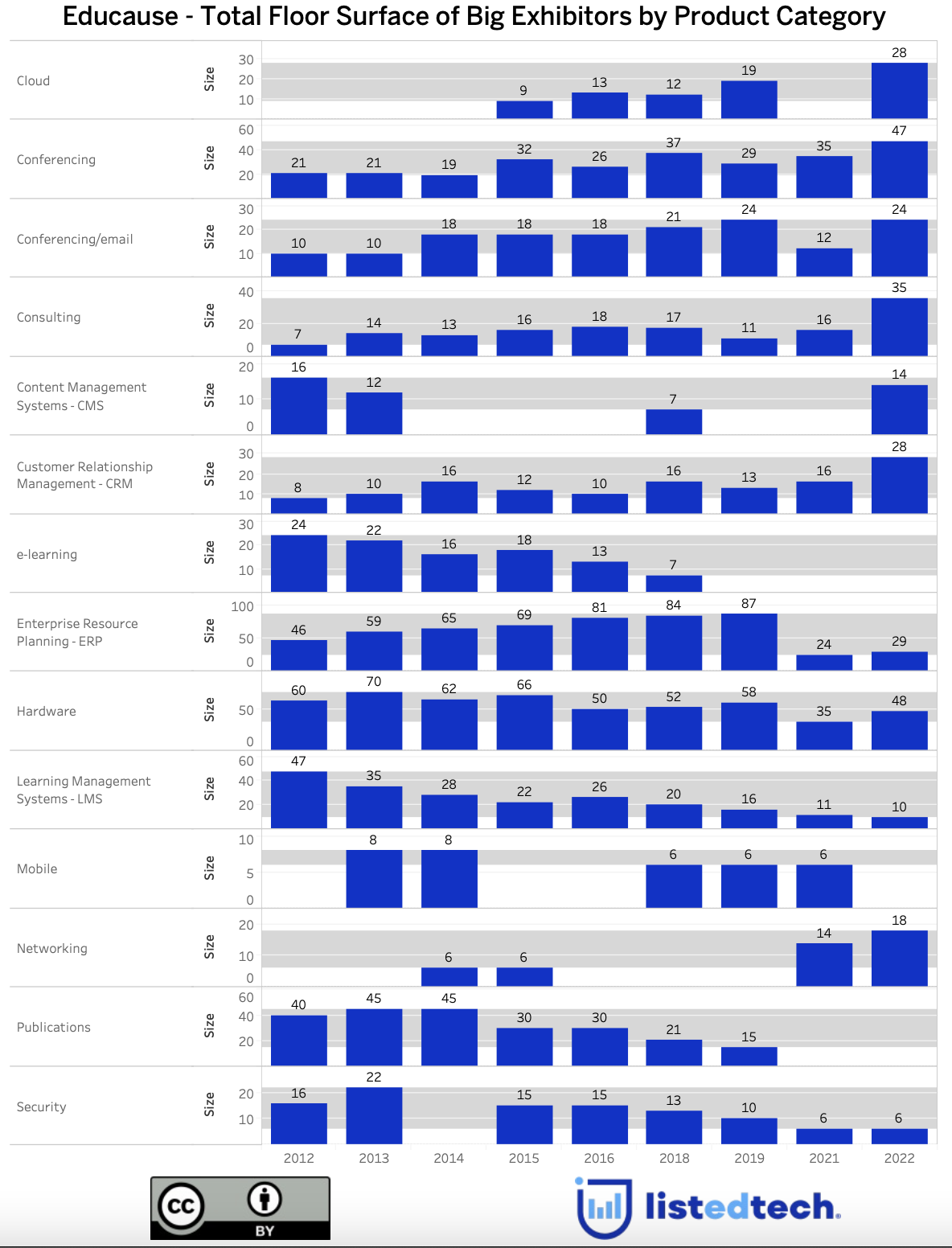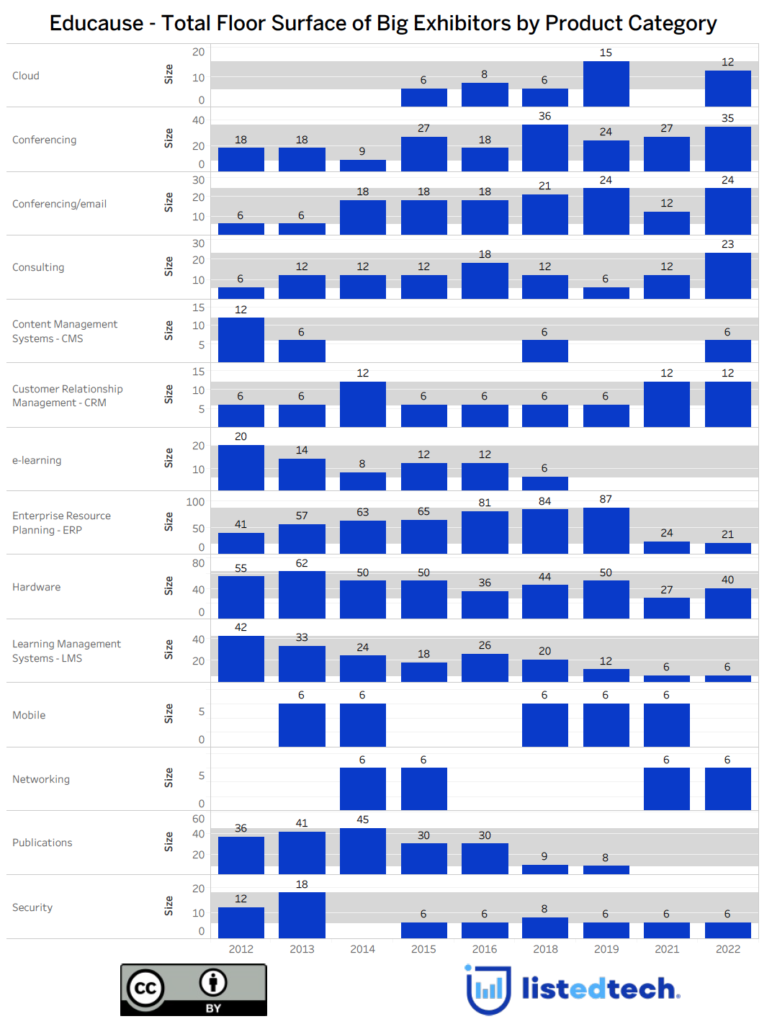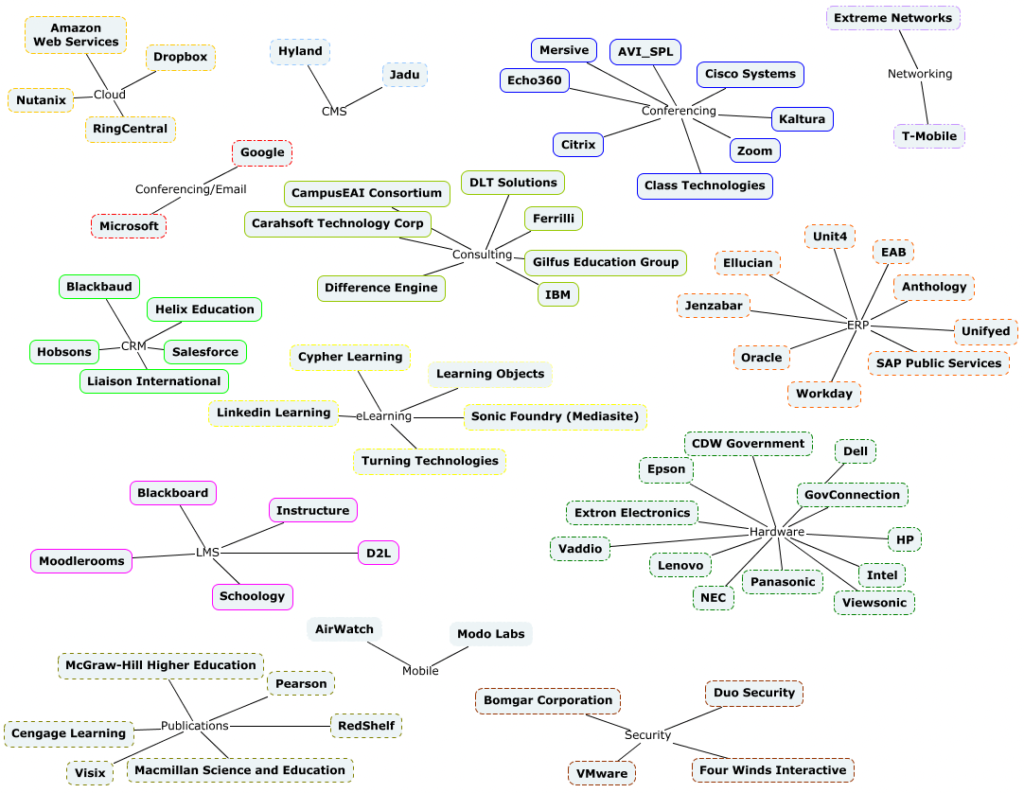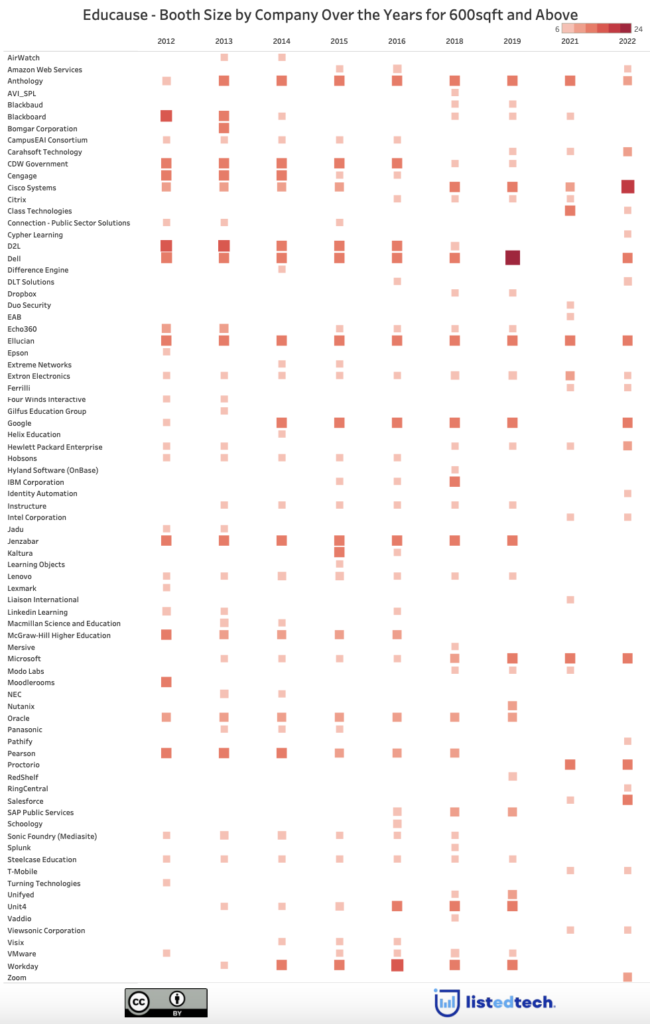
This week, it’s Educause annual conference with its second in-person participation after the online-only pandemic year. After the 2021 conference, we wrote about the floor plan possibly reflecting the market trend. Will this year’s floor plan show the same results?
Research Methodology
I first retrieved all floor plans and exhibitors’ lists since 2012 (except for 2017 -not available- and 2020 -no in-person conference). I then looked at all the bigger booths and listed them. I consider a big booth covering six squares or more on the floor plan (the smallest possible booth being one square). Please refer to the table below to understand the most common area size used on the floor plan: the numbers in italics (right columns) are what I consider the big exhibitors.
| Numbers of squares | Area Size | Number of squares | Area Size |
| 1 | 100 sq. ft. | 8 | 800 sq. ft. |
| 2 | 200 sq. ft. | 9 | 900 sq. ft. |
| 4 | 400 sq. ft. | 12 | 1,200 sq. ft. |
| 6 | 600 sq. ft. | 15 | 1,500 sq. ft. |
As previously mentioned, the year 2017 was not retrievable, and I decided not to include 2020 in this analysis because the conference was 100% virtual, making things harder to compare. Let’s add an important note before going into the analysis. Although the in-person sessions and the exhibitors’ hall are back, the conference’s virtual component is still an option preferred by many participants. Also, it is unsure if companies still have corporate policies related to COVID-19 and have decided to refrain from participating in face-to-face conferences and fairs. Most likely, this is a thing from the past but it could still impact the exhibitor participation.
General Findings
- Between 2012 and 2022, 79 different companies selected a big booth to promote their products or services. For the 2022 conference, six new companies have decided to buy a big kiosk (Cypher Learning, Identity Automation, Pathify, RingCentral, Viewsonic and Zoom). The year with the most considerable number of big booths was 2018, with 34 booths. In 2022, the floor layout only showcases 23 booths with six squares or more, the second smallest number of big exhibitors since 2012.
- The HigherEd IT sector is very volatile when it comes to selecting big booths at the Educause annual conference. Between 2012 and 2021, 22 exhibitors bought a bigger booth (6-square and more) only once. Most of these companies are not the top vendors of their product categories. Between the 2021 edition and this year’s, we saw bigger exhibitors downsizing their kiosk size; for example, Liaison International went from 6 to 4, and EAB went from 6 to 2, while others completely vanished from the floor plan (Modo Labs, Citrix). We might think that some companies did not have the breakthrough expected from attending Educause annual conference.
- NEW – For this update, I wanted to know if Educause would welcome a higher percentage of big exhibitors in 2022, similar to the pre-pandemic numbers. This year, Educause seems to have 0.5% fewer large exhibitors (8.5% total vs 9% in previous years).
- NEW – I also took the time to count each booth to know how many companies have been present at each Educause conference since 2015. In 2015 and 2016, Educause welcomed 373 and 374 different exhibitors, respectively. In 2018, many companies did not renew their kiosk space or buy new spaces and Educause lost about 100 exhibitors (273 companies attended the Exhibitor Hall that year). The 2019 edition fared a bit better with 315 exhibitors. Then the pandemic hit, and only 214 companies bought a booth last year. This year, it’s still not back to normal, but Educause sees an increase in attendance: 272 companies have a physical space to meet with potential or existing clients and make connections.
- Since 2012, very few companies have been present as big exhibitors each year. We only count three: Anthology (avg size of 11.2), Ellucian (avg size of 12) and Extron Electronics (avg size of 6.8). For instance, other companies (Cisco, Dell, Microsoft or Dell) were present for almost the whole period of our analysis but missed a year or did not buy a big kiosk at some point.
The Presence of Specific Product Categories
Looking at the graph, we can see that some product categories disappeared over the years while others took bigger booths. Please note that a product category must have more than one company selecting a big kiosk during the analysis period to be included in this graph. For this reason, you won’t see Business Intelligence, Furniture or Proctoring in the product category graph.

- Once vital to higher education, the publishing industry no longer appears to select big booths. McGraw-Hill Higher Education, Pearson and Cengage Learning were all 12-square booths or 9-square booths in 2012, 2013, and 2014. In comparison, in 2022, Cengage Learning has a 1-square kiosk, and the two other companies completely vanished from the floor plan.
- The hardware industry is another example of the transformation of the higher education IT sector. When comparing the floor plans from 2012 to 2021, we know that computer labs take up less and less space on higher education campuses as students bring their laptops. Universities and colleges no longer need to invest massive chunks of their budget in server rooms as cloud solutions are evolving into the preferred implementation choice. In 2012 and 2013, five hardware companies were among the big booths. In 2014 and 2015, their numbers dropped to four. In 2022, four hardware companies are still part of the prominent exhibitors: Dell (12), HP (10), Intel (6) and Viewsonic (6). Viewsonic is a new big exhibitor for the 2022 conference. Lenovo, which has been a major exhibitor since 2012, opted for a 2-square booth this year.
- Like the SIS market, the LMS market is almost saturated, especially in the Higher Education submarket. Therefore, the business approach has evolved since the early 2010s. The most probing proof of this situation is the presence of Desire2Learn/D2L at the Educause annual conference. In 2012 and 2013, the company spread its booth across 15 squares (the biggest available at the time). Since then, D2L has reduced its booth size from 15 to 12 to 8 to 1 in 2021 and back to 2 in 2022.
- Pre-pandemic, the ERP product category was the most stable. Anthology (previously advertised as Campus Management and Blackboard at Educause) and Ellucian have had two oversized booths since 2012. Jenzabar, which used to have a 12-square booth until 2019, decided not to be an exhibitor this year. The same goes for Unit4, which bought a 6-square booth in 2013 and 2014, an 8-square in 2015 and a 12-square in 2016, 2018 and 2019 but has been absent since 2021. The reason for the disappearance of Unit4 since 2021 is probably related to separating the SIS business and the launch of Thesis.

How Acquisitions and Financial Struggles Impact the Floor Plan
The more I examine the Educause floor plan data, the more I notice that the economic cycles impact the annual conference. Some companies appear or disappear following a merger or an acquisition.

- AirWatch, after its acquisition by VMware in 2014, disappeared from the floor plan. VMware continued to be a prominent exhibitor until 2019.
- The significant drop in sizes (from 12 squares in 2012 to 1 square in 2022) for Cengage booths can be explained by two events. In 2013, the company filed for Chapter 11 bankruptcy. Following its restructuring in 2014 and 2015, the company now focuses more on online learning solutions.
- Dropbox was present in 2018 and 2019, with a 6-square booth each year. In 2021, the company was not part of the exhibitors’ list. We could explain this situation through the workforce reduction that occurred in January 2021.
- With the recent purchase of some of Hobsons’ products, EAB entered the big exhibitors’ group in 2021 with a 6-square booth. In 2019 and 2018, it occupied a 2-square kiosk and was absent in 2016. However, for the 2022 conference, it is back in the smaller exhibitor group with a 2-square kiosk.
- Since 2012, Echo360 has always been a prominent exhibitor, except in 2014 when the company selected a small 2-square booth. Nothing can explain this situation, especially since the company announced in November 2014 an $18M venture capital investment. Note that for the 2022 edition, the company returns to the Educause floor with a 2-square booth, following an absence in 2021.
- Except for 2021, Hobsons has been on the exhibitors’ floor of Educause since 2012. Between 2012 and 2016, it bought a 6-square kiosk. In 2018, it decided to downsize to a 4-square and to a 1-square in 2019. With its purchase by PowerSchool and EAB in 2021, the company is no longer active.
- Hewlett Packard Enterprise/HP has been present on and off the Educause exhibitors’ floor plan. From 2012 to 2021, when it decided to buy a booth, it always chose a 6-square kiosk. Between the years 2014 and 2016, HP did not purchase any booths at the Educause annual conference. I have found that HP proceeded with massive job cuts between 2012 and 2014 that followed critical security vulnerability and hacking attacks. HP has its biggest booth since 2012 with a 10-square kiosk this year.
- Microsoft, with its many products targeting the higher education sector, has been at Educause since 2013. While it offered its Office suite, including Outlook, it was rather timid with a 6-square kiosk. More recently, it has grown its booth to reach 12 squares in 2019 and has remained at that size since then.
Based on these nine years of data, I can say that the Educause floor plan is unsurprisingly linked with the market trends. We have noticed that when misfortune hits a company, the following Educause annual conference is somewhat impacted. Overall, when a company does well, it seems to want to invest in a larger booth to increase its visibility and networking. A case in point is Zoom, which saw record sales in the pandemic years and has bought a 9-square kiosk this year, its first-ever purchase.
I would like to hear what you think about this post. Comment on Twitter, LinkedIn, Facebook and Instagram.
Note: we have verified the floor plan information on October 10, 2022.

